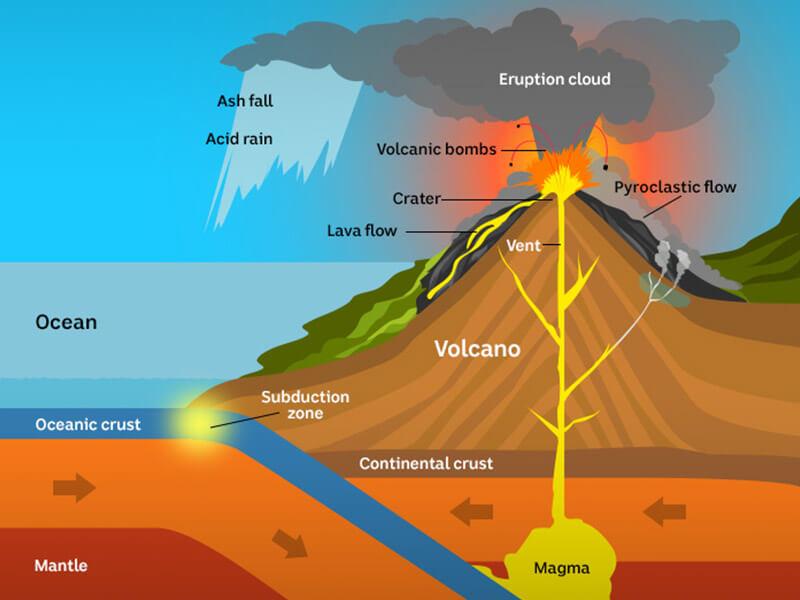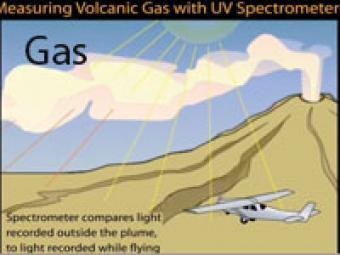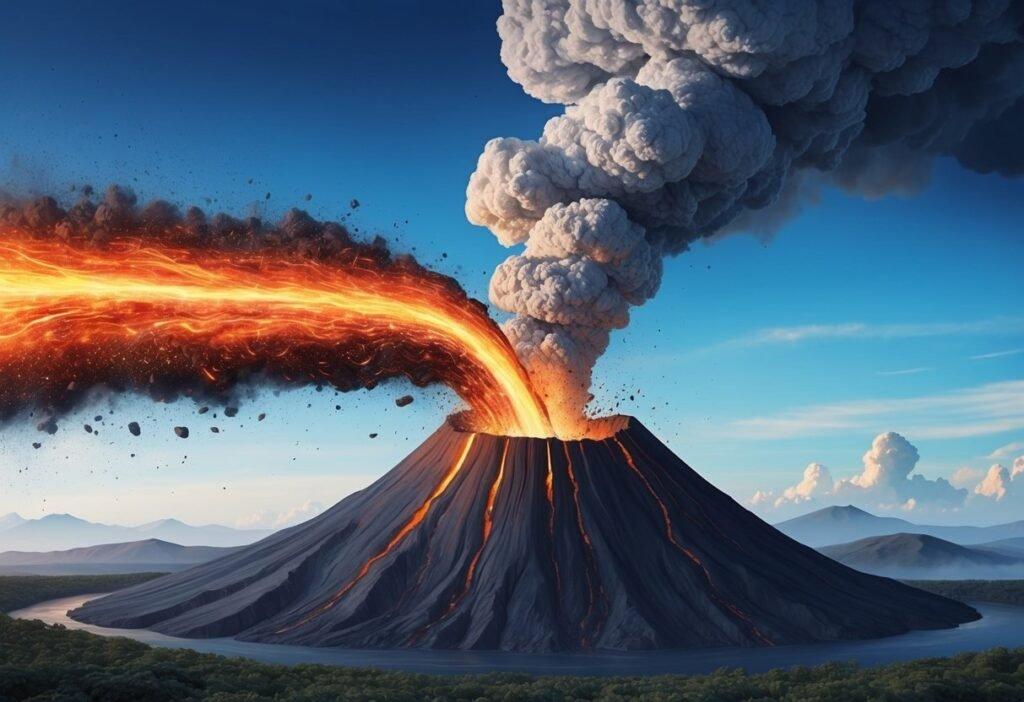Beneath the Earth’s surface lies a realm of intense heat and untold power, where molten rock and simmering gases await their moment to burst forth in breathtaking displays of nature’s fury. Volcanoes, often seen as mere symbols of destruction, are intricate systems that hold enormous scientific significance, revealing vital insights into our planet’s geological processes. From the awe-inspiring eruption of Mount Vesuvius that preserved the ancient city of Pompeii to the quiet rumblings of Icelandic volcanoes that shape the landscape, these natural phenomena are both magnificent and terrifying. As we delve deeper into the science of volcanoes, we will uncover the mechanics behind their eruptions, the intricate interplay of tectonic plates, and the profound impact they have on our environment and climate. Join us on this journey to explore the eruptive secrets locked within the heart of the Earth, illuminating the forces that have shaped our planet across millennia.
Table of Contents
- Understanding Volcanic Activity: The Geology Behind Eruptions
- Predicting Eruptions: Innovations in Monitoring Techniques
- The Impact of Volcanic Eruptions on Climate and Ecosystems
- Preparedness and Response: Safeguarding Communities from Eruptive Threats
- To Wrap It Up
Understanding Volcanic Activity: The Geology Behind Eruptions

At the heart of volcanic activity lies a complex interplay of geological processes. The Earth’s crust is not a uniform shell; rather, it is fractured into tectonic plates that float on the semi-fluid mantle beneath. When these plates converge, diverge, or slide past one another, they generate significant pressure. This interplay creates pathways for magma to rise from the mantle, leading to eruptions. The nature of the magma—a mixture of molten rock, gases, and crystals—plays a pivotal role in the eruption style. Viscous magma, rich in silica, traps gases, building pressure until it explosively releases, while less viscous magma flows more easily, resulting in gentler eruptions.
Understanding the dynamics of volcanic eruptions also involves recognizing the role of different volcano types. Here are a few categorized by their eruption styles:
| Volcano Type | Eruption Style |
|---|---|
| Shield Volcanoes | Gentle flows of low-viscosity lava |
| Stratovolcanoes | Explosive eruptions with pyroclastic flows |
| Cinder Cones | Strombolian eruptions; ejected lava fragments |
Each type offers unique insights into the volcanic landscape and its associated risks. By examining the characteristics of these volcanoes, scientists can better predict when and how eruptive activity might unfold, protecting communities and enhancing our understanding of the Earth’s processes.
Predicting Eruptions: Innovations in Monitoring Techniques

Advancements in technology have ushered in a new era of volcanic monitoring, enabling scientists to predict eruptions with greater accuracy than ever before. Modern techniques leverage a myriad of data sources, making it possible to assess a volcano’s behavior in real-time. Some of the most innovative methods include:
- Remote Sensing: Utilizing satellites equipped with thermal imaging and gas detection systems, researchers can monitor changes in a volcano’s surface temperature, which often precedes an eruption.
- Seismic Monitoring: By deploying a network of seismometers, scientists can detect the minor earthquakes and tremors that typically occur as magma rises to the surface.
- Ground Deformation Analysis: GPS and InSAR technologies allow for the detection of ground swelling or sinking, indicating potential volcanic activity.
To enhance predictive capabilities, interdisciplinary approaches are being adopted, merging geology, geophysics, and computer science. This fusion has led to the creation of sophisticated models that simulate volcanic activity, helping researchers better understand potential eruption scenarios. For instance, the following factors can significantly influence eruption predictions:
| Factor | Impact on Prediction |
|---|---|
| Magma Composition | Affects viscosity and gas release, influencing eruption style. |
| Historical Eruption Data | Provides context for future activity and trends. |
| Volcanic Gas Emissions | Changes in gas ratios can signal impending eruptions. |
The Impact of Volcanic Eruptions on Climate and Ecosystems
Volcanic eruptions are not just spectacular displays of nature’s power; they serve as transformative events with profound implications for our planet’s climate and ecosystems. When a volcano erupts, it releases ash, sulfur dioxide, and water vapor into the atmosphere. These materials can lead to significant climate shifts, particularly in the short term. For example, the sulfur dioxide can form sulfate aerosols, which reflect sunlight away from the Earth, potentially causing global temperatures to drop. This phenomenon was notably observed following the eruption of Mount Pinatubo in 1991, which resulted in a cooling effect that lasted for several years, demonstrating how volcanoes can alter climate patterns on a global scale.
Beyond their climatic impact, eruptive events can reshape local ecosystems, often resulting in both immediate destruction and long-term regeneration. The scenarios in post-eruption landscapes can vary widely: some areas may experience a temporary loss of biodiversity, while others may see unexpected growth and resilience. The infused nutrients from volcanic ash can breathe new life into the soil, fostering robust plant life in the aftermath of an eruption. Consider the following effects:
- Habitat Creation: New landforms and nutrient-rich soils can create new habitats.
- Species Adaptation: Some species may evolve or adapt to thrive in the newly formed conditions.
- Ecological Succession: The recovery process can lead to increased biodiversity over time.
| Type of Impact | Short-term Effects | Long-term Effects |
|---|---|---|
| Climate | Temperature drop | Altered weather patterns |
| Vegetation | Destruction of flora | Soil enrichment and new growth |
| Wildlife | Displacement of species | Adaptation and species repopulation |
Preparedness and Response: Safeguarding Communities from Eruptive Threats
In the shadow of majestic peaks, the threat of volcanic eruptions looms large, prompting communities to focus on preparedness and response strategies. By implementing a robust framework that prioritizes community safety, we can mitigate the risks associated with these natural phenomena. Key strategies include:
- Education and Awareness: Informing the public about volcanic risks and the science behind eruptions.
- Emergency Planning: Establishing evacuation routes and procedures to ensure swift action during an eruption.
- Monitoring and Research: Utilizing technology to predict eruptions and understand volcanic behavior better.
The effectiveness of preparedness relies heavily on community involvement and a coordinated response plan. Local authorities should engage in regular drills and simulations, fostering a culture of readiness among residents. Consider establishing a local response team composed of volunteers trained in first aid and emergency protocols. A well-structured approach can be visualized as follows:
| Preparedness Activity | Frequency | Responsible Parties |
|---|---|---|
| Community Workshops | Quarterly | Local Government |
| Evacuation Drills | Biannual | Emergency Services |
| Volcano Monitoring Updates | Monthly | Scientific Institutions |
To Wrap It Up
As we draw the curtain on our exploration into the dynamic and awe-inspiring world of volcanoes, we emerge with a deeper understanding of the forces that shape our planet. From the fiery magma deep within the Earth’s crust to the ash clouds that dance high above, volcanoes are not merely destructive elements; they are vital contributors to the tapestry of life, influencing ecosystems, climate, and even the formation of new land.
As we continue to unveil the secrets of these eruptive giants, it becomes clear that the study of volcanoes is as much about understanding past events as it is about predicting future ones. With advancing technology and dedicated research, we stand at the brink of unlocking mysteries that have lain dormant for millennia, turning the volatile nature of these natural wonders into valuable lessons for humanity.
In the dance of geology, creativity, and resilience, volcanoes remind us of our connection to the Earth—an invitation to respect, learn from, and prepare for the eruptions of tomorrow. Let us carry forth this knowledge, not only to marvel at the spectacle of nature but to safeguard our future in an ever-evolving world.



